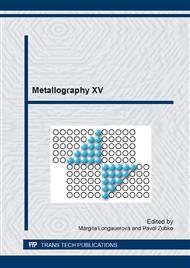p.347
p.353
p.359
p.365
p.369
p.373
p.379
p.384
p.390
Unconventional Metallographic Methods for the Structural Characterization of Laser Hardened Al-Zn-Si Cast Alloy
Abstract:
The laser surface hardening is method which provides increased mechanical properties of secondary (recycled) Al-Si cast alloys for automotive industry. Improvement of mechanical properties and structure of secondary aluminium alloys can often significantly increase the lifetime of casting and reduce costs for fuel and reduction of environmental loading. For study was used a laser beam Nd: YAG lasers, BLS 720, on the test samples of secondary cast alloy AlZn10Si8Mg. AlZn10Si8Mg cast alloy are used for engine and vehicle constructions, hydraulic unit and mould making without the need of heat treatment because this alloy is self-hardened. The effect of laser beam was evaluated with the laser power 50 W and 80 W on the surface of samples. The final microstructure of Al-alloys depend on the laser process parameters. The changes of microstructure after laser surface hardening was observed by using classical techniques of etching (standard black-white contrast - etching by 0.5 % HF, 10 % H3PO4 and colour contrast - etching by Weck-Al) and deep etching with HCl. Due to the action of laser beam on the surface of the secondary alloy AlZn10Si8Mg there have been changes in the microstructure of the material. Melting area is alpha-phase with much fine columnar dendrites morphology without the presence of Si-particles and intermetallic phases. In the transition area were observed grain refinement of eutectic Si (finer and rounder Si particles) as the modify action of the laser. By increasing the laser power the microhardness of surface layers decreases. In the surface layer (80 W) were observed cracks due to uneven heat transfer of the material.
Info:
Periodical:
Pages:
369-372
Citation:
Online since:
April 2014
Authors:
Price:
Сopyright:
© 2014 Trans Tech Publications Ltd. All Rights Reserved
Share:
Citation:


